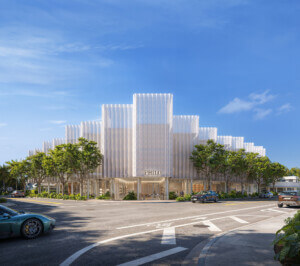The June 24 collapse of Champlain Towers South in Surfside, Florida, left questions that will take years to answer: What caused the structural failure? What parties bear responsibility? What can be done for the survivors? And perhaps most critically: What other local buildings may also be at risk, requiring measures to prevent similar incidents, from urgent repairs to preventive evacuation and demolition?
Curiously missing from the extensive media coverage to date is any detailed characterization of the collapsed building’s architect. Whether his design, its realization, deferred maintenance, or other factors caused the structure to fail remains uncertain, at least until investigations are complete; still, documented professional lapses on his part predated the construction of Champlain South by over a decade and caused the Florida State Board of Architecture to suspend his license for six months in 1967. His legal dispute with the board over the decision in 1966 created a public legal record, and the board’s more extensive files contain substantial adverse information that bears consideration as the wider architectural community grapples with the challenges of protecting public safety. Champlain South was not the first structural failure associated with him.
The name of William M. Friedman (1930–2018) surfaced in the 2018 engineering report by Morabito Consultants warning the Champlain Towers South condominium association about the building’s condition. A key passage in structural engineer Frank Morabito’s document describes the flat, non-sloping pool slab of reinforced concrete, prone to accumulating rainwater rather than draining properly, as “a major error in the development of the original contract documents prepared by William M. Friedman & Associates Architects, Inc., and Breiterman Jurado & Associates, Consulting Engineers.”
Both Friedman’s firm and Breiterman Jurado are out of business, the former inactive since before Friedman’s death despite listings in several unofficial business directories, the latter involuntarily dissolved in 1988. Florida’s Department of Business and Professional Regulation (DBPR) lists Friedman’s license as “null and void,” expiring in 2005. Messages left at a number listed for Friedman & Associates were not returned.
Defunct firms can be easy scapegoats, and deceased architects are not in a position to defend themselves. The scarcity of public information about Friedman, moreover, leaves him exposed to the kinds of conjectures that inevitably follow major disasters. His obituary in the Miami Herald emphasizes his hobbies and sociability as much as his work; he graduated from a major university’s architecture program (BArch, University of Florida, 1953) but kept a relatively low professional profile.
“We have no record of William Friedman as a member and haven’t heard anything anecdotally from members with reference to him,” reported Vicki L. Long, CAE, Hon. AIA, executive vice president and CEO of AIA Florida. He was also unknown to the national organization. “Mr. Friedman was never an AIA National member,” said Matt Tinder, AIA’s senior manager for media relations. “AIA National does not have any records or information about him.”
Emporis lists five buildings designed by Friedman: three in the Champlain Towers complex (the now-demolished South, 1981; North, 1981; and East, 1994); Mirage on the Ocean (1995) in Surfside; and James Central Towers (1968) in Miami Beach. Representatives of these buildings’ real estate offices did not reply to inquiries about Friedman by press time.
One of the rare references to Friedman in public documents is a cryptic court decision from Oct. 25, 1966, in which Florida’s Third District Court of Appeal denied his petition to overturn the Board of Architecture’s six-month suspension of his registration, for causes not specified. The court found that one of two counts against him was “properly and sufficiently proven,” rejected the other count, and imposed a “new and proper suspension order in accordance with his conviction under Count One.” DBPR has located an 86-page file on this case, reported deputy communications director Patrick R. Fargason, representing the Board of Architecture. DBPR’s policy for release of such records includes internal review and redaction of nonpublic information, completed shortly before press time; the department accordingly provided the file to this reporter.
The file on Friedman comprises correspondence and legal documents pertaining to his suspension, reinstatement, initial licensing, and related matters. The charge against him that stuck concerned a commercial building at 2625 Southwest 22nd Street in Miami whose sign pylons did not meet Dade County code and collapsed during a hurricane in September 1965, as did components of two other Friedman buildings, one commercial sign pylon and one residential roof. A board hearing on May 20, 1966, with legal counsel present, unanimously found Friedman guilty of “gross incompetency,” dismissing five other counts on non-unanimous decisions, including the one invalidated by the District Court of Appeal, and suspended his license. He appealed for reinstatement to the Florida Supreme Court, which dismissed his appeal on April 6, 1967; after a final appeal failed, he was suspended from June 1 to December 1, 1967.
A vaguer but potentially more troubling item is an anonymous whistleblower letter to the board dated November 1, 1967, and retyped in the board’s office. Authored by “a graduate architect working in a local office,” this letter assails 12 local architects as “persons whose only interest is to make a fast buck and who do not care about the dignity of their profession. It has come to my attention, and I understand it is common knowledge between builders and ‘professional designers,’ that the following persons will seal any set of plans that you bring them,” writes the correspondent, before offering a non-alphabetized list of names. William Friedman’s appears at the top. The whistleblower also charges two of them (not including Friedman) with advertising, a practice banned at the time by the AIA.
An April 8, 1963, letter from board executive secretary W. Richard Glavin regarding a Friedman employee’s intent to sit for the state exam notes that “Friedman was at one time called before the Board for possible plan stamping.” Glavin’s file memo of March 28, 1963, describes informal inquiries about Friedman among Miami architects; he found no information but noted that he would keep checking. An April 11, 1955, letter to Friedman from another board official (secretary-treasurer Mellen C. Greeley) regarding his certificate of registration, shortly after he passed the junior exam in January of that year (having failed on his first attempt in June 1954), includes this admonition: “Your attention is directed to the rules regarding use of a seal. This information has been sent you previously but we will be glad to answer any questions you may care to ask.” The portrait that emerges from these documents suggests that the board had Friedman on its radar over these offenses for several years before taking action against him.
Structural engineer Allyn Kilsheimer, based in Washington, D.C., and contracted by the city of Surfside to investigate the collapse site and the sister tower Champlain Towers North, has examined the Champlain South construction documents (available in public records) and is reluctant to single out Friedman for culpability. “I know nothing about him, and I’ve learned nothing about him at all, and I’ve never heard of him before,” Kilsheimer said. “All I have are the drawings he prepared.” Having worked in building design, construction, and collapse forensics for five decades, Kilsheimer recalls “the kind of drawings we would get from architects” in the era when Champlain South and North were built. “The drawings that I saw from him, if I compare them to what I remember we were seeing 40 years ago, it’s pretty much the level of drawings that we would see at that point in time…. Back then a lot was left up to the contractor to make decisions on, but that’s how it was done at the time.” He has found no anomalies or unique features in Friedman’s documents, assessing them as “conceptually up to the standards of the day, when they were being prepared, based on my experience.”
Champlain South was “a conventional mild-steel-reinforced flat-plate concrete building… and our office probably did a hundred of them back in that era,” Kilsheimer said. In that setting, “you have to meet the 1979 Southern Building Code, which is what this building was designed under, and it is not nearly as specific about many, many things as today’s codes are…. I remember seeing some drawings back then where you’d see an elevation of the building, and it would say, ‘facade by contractor.’ That isn’t what this guy said. He gave a lot more information than that.”
Responses to building collapses (particularly by lawyers), Kilsheimer observed, if not attributable to “a God-driven structural failure,” often target an architect because the structural engineer was the architect’s consultant. “I’d love to blame architects for as many things as I possibly can,” Kilsheimer said, “but I don’t see how you would blame the architect if his structural engineer made a mistake.” At the Champlain South site, as investigations continue and commentators direct spotlights toward the developers, the condo association, former Surfside building inspector Rosendo Prieto, and even a U.S. Navy offshore test explosion 250 miles north near Daytona Beach, conjectures about responsibility remain premature. Kilsheimer refrains from blaming members of either profession.
South Florida’s long-standing reputation for regulatory capture during its 1980s building boom, locals note, is not limited to detective novels or episodes of Miami Vice. This is a region where developers and civic officials are chummy enough that a well-connected construction firm (Munilla Construction Management) implicated in the multi-fatality collapse of a pedestrian bridge near Florida International University in 2018, and subsequently bankrupted, could then be awarded a major airport contract as if nothing had gone wrong.
Surfside is not Miami, however. The small North Beach city (population: 5,725) maintains a separate government and has been described as wealthy and somewhat sleepy. Whether its scale and profile are conducive to narratives of malfeasance will remain unknown for some time, though this may not forestall attempts to connect the dots. Efforts either to connect Friedman substantively to the tragedy or to ascertain whether he is being inaccurately censured for it will be hampered by the shortage of dots he left to connect.










